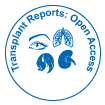Editorial Open Access
Problems and Possibilities in Tissue Engineering
Prakash S Bisen*
School of Studies in Biotechnology, Jiwaji University, Gwalior 474005, India
- *Corresponding Author:
- Prakash S Bisen
Jiwaji University, Gwalior 474005, India
Tel +91 751 2462500
E-mail: psbisen@gmail.com
Received date: October 05, 2015 Accepted date: October 08, 2015 Published date: October 18, 2015
Citation: Bisen PS (2015) Problems and Possibilities in Tissue Engineering. Transplant Rep 1:e101.
Copyright: © 2015 Bisen PS. This is an open-access article distributed under the terms of the Creative Commons Attribution License, which permits unrestricted use, distribution, and reproduction in any medium, provided the original author and source are credited.
Visit for more related articles at Transplant Reports : Open Access
Organ and tissue transplantation in developed countries is in steady increase. We are living in fast changing world with path-breaking technological advancements as a norm of the day. Development of the field of organ and tissue transplantation has accelerated remarkably since the human major histocompatibility complex (MHC) was discovered. The major histocompatibility complex (MHC) contains a set of cell surface molecules responsible for binding peptide fragments derived from pathogens and display them on the cell surface for recognition by the appropriate T cells. They are located on chromosome 6 having more than 200 genes in human controlling major part of the immune system responsible for tolerance and rejection of grafts and in graft against host diseases with a decisive role in vertibrates with the help of antibodies, antigen presenting cells, helper and cytotoxic T cell subsets, immune cell surface molecules, signaling mechanisms and cytokines that they release. Combinations of these agents work synergistically, leading to lower doses of immunosuppressive drugs and reduced toxicity. In humans these genes are called Human Leukocyte Antigen or HLA genes. Human MHC genes are highly polymorphic. When an organ is congenitally defective or absent or when an organ or tissue is damaged due to injury or disease, grafting is done to restore the function. White blood cells (WBCs) are immune cells and the interaction of MHC molecules with other leukocytes or with body cells is mediated through interactions of leukocytes (white blood cells - WBCs), with other leukocytes or with body cells. The grafting of tissues of cells and scaffold (extracellular matrices that provide support to cells) is based on creating suitable conditions under which cells are kept is termed as Tissue engineering. There are whole networks in some parts of the world, and these methods have significantly prolonged lives of many people. With these advancements, it should not be the over-optimistic expectation to believe that gene therapy “the method of transfer of genetic material into individuals” for therapeutic purposes by altering cellular function or structure at the molecular level used in conjunction with tissue engineering as a hybrid and upcoming approach. This combination of stem-cell-based tissue engineering with gene therapy has the potential to provide regenerative tissue cells within an environment of optimal regulatory protein expression and would have many benefits in various areas such as the transplantation of skin, cartilage or bone. I firmly believe that this would be possible by effective approach with the availability of therapeutic targets as desirable options for management of transplanted tissue. Gene expression profiling through microarrays is regarded as a promising tool in understanding the transcriptional changes linked with tissue engineering particularly in human articular cartilage grafts. Major challenges for TE is the need for more complex functionality, providing additional factors for tissue and organ development and development of ideal scaffolds. However, there are some shortcomings in simple organ and tissue transplantations with the difficulty in scarcity of matched organs for people who are waiting for transplantation. The other drawback is constant immunosuppressive therapy which can damage health of the patients, impracticability of nerve transplantation, and limited life span of transplanted organs are also big disadvantages of this technique. There is still lot of hard but not the impossible task to achieve objectives in tissue engineering. Repairing and replacing the malfunctioned organ or preserving and improving of the function in vital organs are additional objectives to attain in tissue engineering. However, only repairing of a lost function is possible at present and other objectives are about to be achieved. Other objectives are possible in future only by developing appropriate technology/methods for constructing whole organs and tissues in laboratories whereby cell would be easily accessible with huge proliferation ability and property to differentiate into desired cell type. This can be achieved by employing (a) autologous cells (cells from the same person (b) allogeneic cells (cells from same species) (c) xenogeneic cells (cells from other species individuals).
Embryonic stem cells have possible tumorigenic properties, therefore, are not that reliable. Induced pluripotent stem cells (iPSC) are an excellent concept providing plenty of autologous stem cells by manipulating adult cells with retroviral activity. However, these cells are likely oncogenic because they rely on retroviral vector that integrates in host’s genom. Cells from placental tissue, umbilical cord and amniotic fluid can be considered as excellent embryonic stem cells having no tumorigenic properties.
In conclusion, possibilities in tissue engineering offer exciting promise for future understanding, but significant technical hurdles remain that will only be overcome through years of intensive research. I conclude this write-up with a sense of optimism that our scientific endeavors would make world better place for generations to come.
--Relevant Topics
- Allografts Transplant Reports
- Bone Marrow Transplant Reports
- Brain Transplant Reports
- Corneal Transplant Reports
- Eye Transplant Reports
- Eyebrow Transplant Reports
- Hair Transplant Reports
- Head Transplant Reports
- Heart Transplant Reports
- Individual Organ Transplants
- Kidney Transplant Reports
- Liver Transplant Reports
- Lung Transplant Reports
- Pancreatic Transplantation
- Stem Cell Transplant Reports
Recommended Journals
Article Tools
Article Usage
- Total views: 12303
- [From(publication date):
December-2015 - Apr 04, 2025] - Breakdown by view type
- HTML page views : 11360
- PDF downloads : 943
